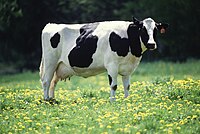
Photo from wikipedia
Metritis is a frequently occurring diseases in postpartum cows and is one of the important reasons for the infertility of dairy cows, accounting for 20–30% of dairy cow diseases and… Click to show full abstract
Metritis is a frequently occurring diseases in postpartum cows and is one of the important reasons for the infertility of dairy cows, accounting for 20–30% of dairy cow diseases and has serious implications for the dairy industry. It has been reported in the literature that the bacterial balance of genital tracts is directly related to the maintenance of physiological function and the development of various diseases of the reproductive system. By analyzing the changes in abundance and diversity of bacteria in the cow uterus from 1 to 35 days postpartum, the objective was to reveal the mechanism of metritis in cows and provide the basis for diagnosis, treatment and prevention of metritis in postpartum dairy cows. Uterine contents were taken from six cows (three healthy and three with metritis) on 1, 7, 14, 21 and 35 days after parturition. DNA genomes extracted from the samples were primed with 515F5′-GTGCCAGCMGCCGCGG-3′ and 907R5′-CCGTCAATTCMTTRAGTTT-3′ for PCR amplification of the V4+V5 regions of the 16S rDNA genes and construction of a gene library. The sequence of the bacterial structure of the cow uterine contents was analyzed using 16S rDNA high-throughput sequencing technology. A total of 30 samples were tested by PCR, and 29 samples qualified. The results of cluster analysis showed that except for one sample, the number of OTUs in the healthy cows was above 200, while in the cows with metritis, except for three samples, OTUs were below 200. The Chao1 and Shannon indices showed that the abundance of bacteria in the cow uterus was lower than that of healthy cows. Analysis of the relative abundance of bacteria in the cow uterus showed that there were six phyla present, including Bacteroidetes, Firmicutes, Fusobacteria, Proteobacteria, Actinobacteria and Tenericutes. There were 10 dominant genera in healthy cows, including Bacteroides, Clostridium sensu stricto 1, Escherichia-Shigella, Fusobacterium, Halomonas, Helcococcus, Porphyromonas, Prevotella 6, Rikenellaceae RC9 gut group and Streptococcus. There were nine dominant genera in cows with metritis, including Bacteroides, Caviibacter, Clostridium sensu stricto 1, Falsiporphyromonas, Fusobacterium, Halomonas, Helcococcus, Porphyromonas and Prevotella 7. Phylogenetic tree analysis showed that uterine contents from 29 samples could be separated into two clusters. Eleven samples from the cows with metritis were clustered with one sample from the healthy group, and 13 samples from the healthy cows were clustered together with four samples from the metritis group. Principal co-ordinate analysis showed that the points representing healthy cows and those representing the metritis group were concentrated in two distinct regions, which shows that there were significant differences in the structure evolution between healthy cows and cows with metritis. The above results indicate that bacterial diversity declines with time postpartum in healthy cows and is lower in cows with metritis, with characteristic changes in the relative abundances, including increases in Bacteroidetes and Fusobacteria, decreases in Firmicutes and Proteobacteria, increases in Porphyromonas, Bacteroides and Fusobacterium, and a decrease in Clostridium sensu stricto 1.
Journal Title: Veterinary and Animal Science
Year Published: 2020
Link to full text (if available)
Share on Social Media: Sign Up to like & get
recommendations!